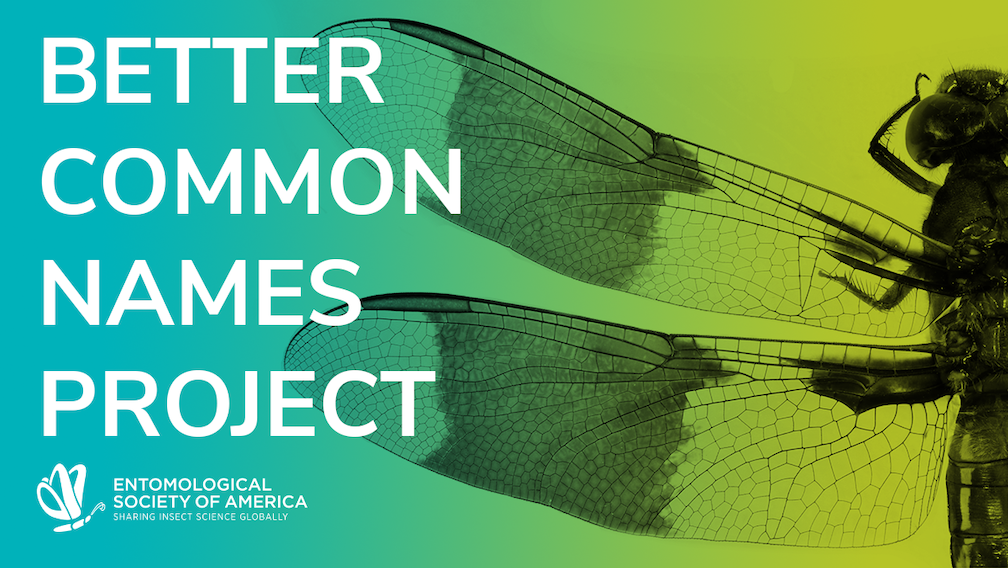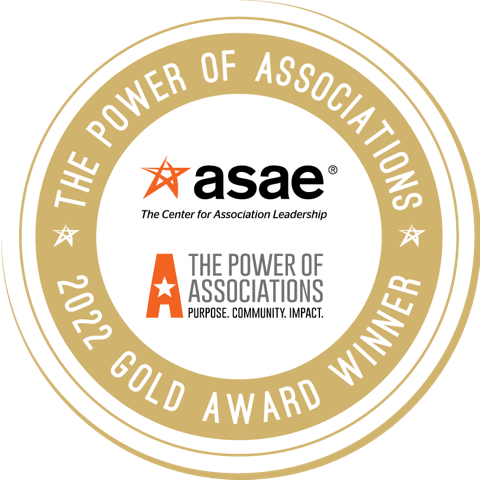
The Entomological Society of America's Better Common Names Project aims to ensure that insect common names are respectful, inclusive, and accurately descriptive.
In 2021, ESA adopted new policies for insect common names to be accepted into the ESA Common Names of Insects and Related Organisms List. The updated criteria bar names referencing ethnic or racial groups and names that might stoke fear; the policies also discourage geographic references, particularly for invasive species.
The criteria are applied to all newly adopted insect common names, and the Better Common Names Project is tasked with reviewing existing insect common names and guiding adoption of new names to replace those that no longer meet ESA's current common name policies.
Background
Entomologists want effective communication with the public, policy makers, and other scientists. Effective communication can help advance science, advance entomology, and increase the flourishing of humans and the environment.
Common names of insects were formally recognized in the early 20th century to help bridge communication between those who study insects and those who don't.
However, not all common names accepted over the past 120 years align with the goal of better communication, and some hinder it. Examples include (but are not limited to):
- Names that contain derogatory terms
- Names for invasive species with inappropriate geographic references
- Names that inappropriately disregard what the insect might be called by native communities
These names perpetuate harm against people of various ethnicities and races, create an entomological and cultural environment that is unwelcoming and non-inclusive, disrupt communication and outreach, and counteract the very purpose of common names.
How the Better Common Names Project Works
To address problematic common names, ESA created a task force charged with spurring action in the entomology community. The task force developed a process called the Better Common Names Project.
Here's how the project works:
- Solicit community input. Through community surveys and other research, the task force has identified several names in the ESA Common Names List that potentially conflict with current naming criteria.
- Recruit working groups. After reviewing community feedback, the task force will note the names most in need of changing and recruit working groups of people who study or work with those insects to propose new names.
- Create and submit proposals. Groups will work with their communities to research new names, build consensus for new names, and submit final proposals for new names that fall within ESA's common names policies.
- Review proposals. Proposals will be reviewed by the ESA Common Names Committee, and accepted proposals will then go to a member comment period for 30 days.
- Final approval. After the member comment period, proposals can be adjusted as needed. Otherwise, final proposals are submitted to the ESA Governing Board for final approval.
A Better Future
By participating in the Better Common Names Project and helping to change problematic common names of insects, you will help ensure that insect common names are respectful, inclusive, and descriptive of the insect. Using better common names will increase the effectiveness of communication with the public, enhance the reputation of entomology and entomologists, build a more inclusive discipline, and reduce harm to our members and non-members alike.
Common Names Amended
The following insect common names have been adopted under direct guidance or advisement from the Better Common Names Project.
- spongy moth (Lymantria dispar)
- ivory spongy moth (Lymantria albescens)
- white-winged spongy moth (Lymantria postalba)
- shadow spongy moth (Lymantria umbrosa)
- rosy tussock moth (Lymantria mathura)
- black-arched tussock moth (Lymantria monacha)
- casuarina tussock moth (Lymantria xylina)
- northern giant hornet (Vespa mandarinia)
- southern giant hornet (Vespa soror)
- yellow-legged hornet (Vespa velutina)
Additionally, common names for the following species have been removed from the ESA Common Names List:
- Lymantria dispar; "gypsy moth" removed, replaced with "spongy moth"
- Aphaenogaster araneoides; "gypsy ant" removed, no replacement
- Matsucoccus resinosae; "Japanese pine blast scale" removed, no replacement
- Oxy velox; "Japanese grasshopper" removed, no replacement
- Opatroidea punctulatus; "Eurasian mealworm" removed, no replacement
- Nysius caledonia; "Caledonia seed bug" removed, no replacement
- Saperda candida bipunctata; "Saskatoon borer" removed, no replacement
FAQs
Haven't people always been able to propose new names? What's the need for this project?
Yes, name change proposals have always been accepted. In late 2020, the ESA Common Names Committee proposed rule changes for acceptable common names, which were approved by the ESA Governing Board in March 2021. The new policies bar common names referencing ethnic or racial groups and names that might stoke fear and discourage geographic references. (Read the full policy.) The new policies also apply to proposals to change previously approved common names, as some of the current common names are no longer in accordance with our policies. This project was launched to raise awareness of the new policies and proactively invite proposals to change existing problematic names.
Isn't this a slippery slope? People could be offended by anything.
The current scope of the project is to address names that are currently contributing to discrimination, exclusion, or harm against people. The task force will not be addressing all names that people could possibly be offended by, but only names that the community flags as being problematic.
What criteria will be used to judge new name proposals?
See "Rules and Guidelines for Proposing a Common Name." Successful proposals will address each rule and will provide evidence of community consultation and support for the new name.
Why doesn't ESA just change the names?
ESA's Common Names Committee doesn't choose names for insects. Rather, through adoption into a formal list, ESA recognizes names that are currently in use or that communities would like to use. These names are submitted and then approved or not approved based on set criteria. Just as new names come from the community, name changes should come from the community, as well. We are also eager to have input from native communities and people from an insect's area of origin regarding names of insects.
What does changing a common name actually do?
Only ESA-approved common names can be used in papers published in ESA journals or used in ESA functions or other communications (website, blog, social media, press releases, public policy resources, and more) . Beyond ESA materials and functions, we rely on scientists and the public to use ESA-approved names to communicate most clearly. We can't control what people call insects, and old names may persist in common usage. However, ESA is committed to leading by example and building community engagement for the adoption of new common names that the public will also adopt in time.
Won't changing common names lead to more confusion, not less?
We understand there are myriad challenges with changing common names, including education efforts, creation of new materials and resources, and resistance to change among colleagues or some members of the public, just to name a few. While this effort is intended to improve communication about insects, we acknowledge it might first lead to a period of adjustment on the way to this goal. ESA will support both the efforts to propose new names and the ongoing process of encouraging their widespread adoption. This isn't a project for one person or one organization. It's a project for the insect science community. And, together as a community, we can make it a success.
Is there any precedent for common names being changed?
ESA has changed many common names for a variety of reasons. Many of the changes are preserved in the archives of American Entomologist (formerly known as the Bulletin of the Entomological Society of America).
Other societies and institutions have updated names of journals, awards, buildings, graduate programs, and more. Recently, COVID-19 variants have been referred to by Greek letters rather than geographic areas in order to reduce stigma.
What's the problem with geographic references in common names?
Referencing geography in a common name for an insect, in particular for invasive or harmful species, can perpetuate discrimination, xenophobia, and bias against people from the same geographic region. For example, throughout history, immigrants, refugees, or "othered" groups have been compared to insects or referenced in entomological terms, and a large body of scholarship has explored this pattern. For further reading on the topic, see:
- Shinozuka's article on how the Japanese beetle influenced anti-Asian policy in the early 20th century and was used as a vehicle to dehumanize Japanese people and persuade Americans that the "invaders" needed to be eradicated.
- Santa Ana's article about anti-immigrant metaphor, specifically "immigrants as animals."
- Anderson's analysis of media portrayals of asylum seekers as vermin or pests.
Furthermore, ESA members have reported being the targets of derogatory comments made in reference to insects with geographic common names, including being called "invasive" due to their ethnicity.
There is also precedent in other areas of study for changing names that reference geographic regions to minimize negative effects on groups or contribute to stigma. For example:
- An article from the Star Tribune discussing Minnesota's decision to refer to the Asian carp as invasive carp to avoid negative effects on Asian-Pacific Minnesotans.
- The WHO advises against using geographic terms to name diseases to minimize negative effects and offense toward any cultural, social, national, regional, professional, or ethnic groups.
ESA is a global society, and increasingly so. Therefore, it's important that the names we call insects are relevant on a global scale; are inclusive of all races, ethnicities, and nationalities; and do not perpetuate harm against people.
How was the task force formed?
The ESA Common Names Committee was given a charge from the ESA President to work with the ESA Diversity & Inclusion Committee to address problematic names in the Common Names of Insects and Related Organisms list. As a result, a joint task force was formed with volunteers from both groups, as well as some at-large ESA members who previously expressed interest in addressing problematic common names.
What is a common name? Is that different from a scientific name?
Organisms often have two names – a common name and a scientific name. For example, "human" is a common name and "Homo sapiens" is the scientific/Latin name. Common names are often different in different regions, while scientific names tend to remain the same across regions. The Entomological Society of America keeps a list of over 2,000 insect common names for the United States of America. Visit the Common Names of Insects Database.
Award
In 2022, the Better Common Names Project was honored as a Gold Award recipient in the Power of Associations Awards by the American Society of Association Executives. The Power of Associations Awards honor "associations that go above and beyond their everyday mission to undertake initiatives that benefit America and the world." ESA congratulates and thanks everyone in the entomology community who has contributed in ways both large and small to this initiative.

